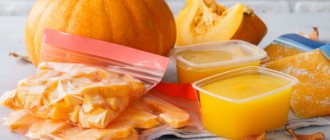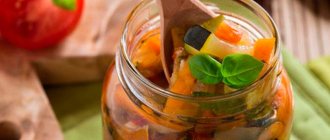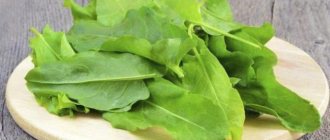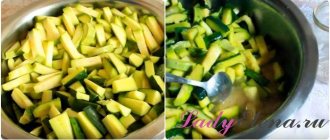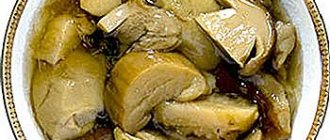How to choose zucchini for freezing
Proper preparation for winter storage is very important.
Of course, the best option for freezing would be homemade fruits, but if they are not available, you need to select zucchini.
They must be young - this can be seen by the thin peel, with small seeds inside. The color can be any: green, white, yellow. The main condition is that everything must be fresh, whole, clean, with shiny skin, without scratches, stains, or rotten places. Only in this case will the prepared vegetables retain their vitamins and shape in the freezer throughout the winter.
Sluggish, long-harvested vegetables are not suitable, the same applies to unripe or overripe ones.
The next step for proper selection is to pierce the peel: if the zucchini is good, the peel is soft and easy to pierce. A hard and hard layer of skin indicates that the pulp is too fibrous.
How to defrost zucchini correctly
Most often, frozen zucchini is not defrosted before cooking . They can be heated in the microwave. If you need to defrost the zucchini, do it in the refrigerator or on the counter at room temperature. The released liquid is drained.
The puree can also be thawed in the refrigerator or at room temperature . Zucchini, cut into slices, are taken out of the freezer, slightly defrosted (halfway), rolled in flour or dipped in batter and fried.
How is zucchini frozen?
There is a way to freeze zucchini so that it doesn't become tough and difficult to cook. The delicate taste will be preserved if the juice is removed from the sliced zucchini circles, cubes or grated mass. Cubes with circles are best blanched, that is, treated at high temperature. It is necessary to place the product in boiling water and stir over moderate heat for 5 minutes. To get rid of zucchini juice, steaming is suitable. The vegetables are then placed in a colander and left until dry and cool.
You can do without heat treatment. To remove excess liquid, sliced vegetables are laid out in one layer on a wooden surface and sprinkled with salt. During the process, moisture will be released - it must be carefully removed with napkins or a towel.
The easiest way to remove liquid from a grated product is. Simply squeeze out all the excess juice with your hands. After this procedure, the pulp is ready for freezing.
After the vegetables have undergone the necessary processing, the chopped cubes are placed in a bag and sent to the freezer. You can use a cellophane or plastic bag with a zipper on top. The main thing is to release all the excess air from it so that the zucchini can be stored for as long as possible without losing the tenderness of its taste. The most convenient way is to fill one container with enough vegetables for one serving. You can add herbs, garlic or other chopped vegetables to the zucchini.
Freezing zucchini slices is done like this. The dried circles are placed on a flat surface covered with cling film. Such surfaces can be, for example, a cutting board or baking sheet. You can cover the first layer with cling film and place another one on top. Vegetables must be placed in the freezer for 2 hours.
Afterwards, the frozen workpiece is pulled out, distributed into bags and sent back. The air must be released from the bags, just like with the cubes.
The process of freezing grated zucchini is not different or difficult. Zucchini mixture can be frozen not only in bags, but also in plastic containers with a lid. Carrots, garlic, onions or herbs are also added to the grated product to taste.
Selection and preparation of zucchini for freezing
We choose small, juicy, fresh zucchini. Then there will be virtually no waste. When collecting independently, we pick them from the garden in the morning or evening. When purchasing, pay attention to the tail. In a stale specimen, it has dried out and turned yellow.
Preparing for freezing:
- Rinse under running water to remove dirt.
- Dry it. Just wipe with a towel.
- Cut off the ends on both sides by about a centimeter.
- Cut, grate, blanch according to the recipe.
It is allowed to use overripe zucchini for making puree, freezing in pieces, or in crushed form. You will need to peel the skin and remove all the pulp.
Methods for freezing zucchini for the winter
The way vegetables are frozen determines what dishes they are best used in.
Blanched in slices
This method of freezing produces excellent vegetables for frying. These zucchini are not suitable for pancakes or vegetable stew.
Instructions for freezing blanched zucchini slices:
- Wash the zucchini and peel off the skin.
- Cut into circles 1–1.5 cm thick.
- Place in boiling water and blanch for 5 minutes. Then place in a sieve or colander and let all the liquid drain.
- Dry each circle and place on a wooden board wrapped in cling film.
- Freeze at the lowest temperature available in your freezer. Then put it in a plastic bag.
Is it possible to freeze zucchini and eggplant?
There is an opinion that frozen eggplants and zucchini become watery and “rubbery” in taste after defrosting. The vegetable itself loses its taste and does not look appetizing. Therefore, many housewives are wondering: is it worth preserving such products for the winter in this way ? Our answer is yes. But it needs to be done correctly.
How to properly freeze zucchini for baby feeding
Don’t trust store-bought baby food, and your baby’s complementary feeding period falls during the cold season? Prepare vegetable and fruit purees yourself! Before freezing zucchini for your child in the freezer, first prepare the product properly. This way you will be sure that the puree contains all the vitamins and microelements your baby needs. How to properly freeze baby foods in the freezer:
- Peel young fruits from peels, seeds, and stalks. Cut into small pieces.
- Boil the water.
- Place the vegetables in boiling water for four to five minutes, remove them with a slotted spoon, and let the water drain.
- Puree the prepared pieces with a blender, place portions into small containers and place the prepared complementary food on the freezer shelves.
We recommend reading these articles:
Treatment of shrubs in spring against pests and diseases
Treatment of cherries in spring against pests and diseases
Spicy adjika from zucchini for the winter, finger licking recipes
Storing with eggplants
Now let's move on to the question of whether and how to freeze zucchini and eggplant for the winter? To answer the first question, we assure you that yes, it is possible.
First you need to remove excess bitterness from eggplants. How to do it? If not all housewives blanch zucchini before freezing, then almost everyone subjects the eggplants to a little heat treatment to make their taste more pleasant.
You can also remove bitterness from eggplants using a dry method: by keeping mugs or slices of eggplant sprinkled with salt for some time. After twenty minutes of salt “therapy,” the blue ones are washed, dried with a towel and subjected to further processing using the method of preparing zucchini for freezing.
Shelf life of zucchini in the freezer
If you freeze fresh zucchini for the winter, they will be perfectly stored in the freezer at - 12°C; - 18 °C and in the freezer at -24 °C; -26°C. The blanks can be kept for up to 10 months.
The only requirement is that you should not repeat the procedure again.
For housewives who prepared supplies only through canning, freezing has become even more popular in use.
Firstly, making them is much easier: it takes less time, effort, and money.
Secondly, canned fruits retain much less beneficial properties. And frozen ones will provide the body with vitamins and microelements.
Which zucchini are suitable for freezing?
To preserve beneficial vitamins and microelements in vegetables, it is better to choose exclusively young and fresh zucchini. In this case, you need to ensure that there is no rot or damage on the skin of the fruit.
If you plan to freeze zucchini for a small child, under no circumstances use overripe or, conversely, underripe vegetables with the slightest damage or traces of rot. Vegetables with very hard skins are also not suitable for harvesting for the winter, since their pulp is too hard and will be tasteless after defrosting. Before freezing, each prepared vegetable must be carefully inspected for damage, dark spots and rot. Before chopping vegetables:
- Cut off the attachment point of the flower and the stalk.
- Wash in running water.
- Dry so that there is no excess moisture on the fruits.
- If overripe fruits are used for freezing, large seeds with adjacent pulp are removed.
- If the skin on the zucchini is too hard, it must be cut off.
Then you need to bring the zucchini into the state in which you plan to freeze them: cut into thin rings, bars or cubes, make puree from the fruit or fry in a frying pan.
Composition and beneficial properties of zucchini
The usefulness of zucchini is indicated by its chemical composition. It contains dietary fiber, there is tocopherol and pectin, biotin, nicotinic, tartronic acids. There are a minimum of fatty acids, no fat or cholesterol, but there is vitamin E, which is an antioxidant.
The vegetable contains beta-carotene and ascorbic acid, which strengthen the immune system. Zucchini contains large quantities of fiber. It contains potassium, magnesium and calcium, as well as retinol, manganese, folate and riboflavin, pyridoxine and phosphorus.
Nutritionists attach particular importance to a vegetable variety called zucchini, which was developed in European countries. It has a more delicate taste, so this product is eaten raw and added to salad.
Due to its composition, zucchini has a number of healing properties:
- Helps with anemia.
- Protects cells from damage due to oxidation.
- Strengthens the nervous system.
- Treats asthma, eye diseases, various bruises, inflammatory processes.
- Strengthens bones and teeth, allows bones to heal quickly in case of fractures, reduces the risk of osteoporosis.
- Supports the functioning of the heart and arteries, reduces blood pressure in case of high blood pressure.
- Has a beneficial effect on the liver, helps the outflow of bile.
- Improves the functioning of the gastrointestinal tract, cleanses it of toxins, waste, prevents the development of constipation and flatulence.
- Speeds up metabolism.
- Reduces the risk of developing cancer.
How to choose zucchini for harvesting for the winter
Reviews from experienced chefs make it clear that in order for frozen zucchini to retain all its beneficial qualities and vitamins, you need to choose ripe specimens without defects.
If you are freezing fruits to later feed an infant, you should choose them carefully: they should not be unripe or too ripe, the peel should be shiny, without defects, rot or cracks. If you freeze a low-quality product, you risk your baby's health.
There is a simple way to check zucchini for winter harvesting: you need to try how the peel is pierced. A specimen that is suitable for freezing will have a soft skin. Fruits with hard or tough skins are not suitable. Once you have chosen a product, you can proceed to processing it for freezing.
Composition and beneficial properties of frozen zucchini
The usefulness of zucchini is indicated by its chemical composition. It contains dietary fiber, there is tocopherol and pectin, biotin, nicotinic, tartronic acids. There are a minimum of fatty acids, no fat or cholesterol, but there is vitamin E, which is an antioxidant.
The vegetable contains beta-carotene and ascorbic acid, which strengthen the immune system. Zucchini contains large quantities of fiber. It contains potassium, magnesium and calcium, as well as retinol, manganese, folate and riboflavin, pyridoxine and phosphorus.
Nutritionists attach particular importance to a vegetable variety called zucchini, which was developed in European countries. It has a more delicate taste, so this product is eaten raw and added to salad.
Freezing zucchini with rice and vegetables
A semi-finished product made from zucchini, peppers, carrots, onions and rice is perfectly stored in the freezer and will help out when unexpected guests arrive.
Ingredients:
- Zucchini – 1 kg
- Sweet pepper – 0.3 kg
- Carrots – 0.3 kg
- Onion – 0.2 kg
- Vegetable oil – 2 tbsp.
- Rice – 1 tbsp.
- Salt – 0.5 tsp.
Zucchini with rice and vegetables
How to cook frozen semi-finished product:
- Wash and dry the vegetables. Cut the zucchini and onion into cubes, remove the seeds and stalks from the pepper and chop into strips.
- Boil the rice in salted water until half cooked.
- Sauté the vegetables in a frying pan with olive oil.
- Mix the vegetable mixture with rice. Stir until smooth.
- Pack the product into containers, bags and place in the freezer.
Attention! Vegetables can also be frozen raw for the winter, and then fried in a frying pan or in a slow cooker using your favorite recipes.
Due to its composition, zucchini has a number of healing properties:
- Helps with anemia.
- Protects cells from damage due to oxidation.
- Strengthens the nervous system.
- Treats asthma, eye diseases, various bruises, inflammatory processes.
- Strengthens bones and teeth, allows bones to heal quickly in case of fractures, reduces the risk of osteoporosis.
- Supports the functioning of the heart and arteries, reduces blood pressure in case of high blood pressure.
- Has a beneficial effect on the liver, helps the outflow of bile.
- Improves the functioning of the gastrointestinal tract, cleanses it of toxins, waste, prevents the development of constipation and flatulence.
- Speeds up metabolism.
- Reduces the risk of developing cancer.
Eating zucchini is allowed every day; the norm for an adult reaches 1.5 kg per day. The best option is to add the product to a vegetable salad. The main thing is not to get carried away so as not to cause negative consequences for the intestines.
Freezing semi-finished zucchini products
Many housewives have a question about whether it is possible to freeze already fried zucchini if part of the dish is left over from lunch. This recipe will answer the question.
Preparing to cook
Required:
- Zucchini – 1 kg
- Salt – 1 tsp.
- Pepper - to taste.
- Flour – 3 tbsp.
- Vegetable oil - 50 ml.
Procurement process:
- Cut the prepared zucchini into slices. Salt the vegetable slices and allow excess liquid to drain.
- Dip vegetable rings in flour and fry in a heated frying pan until golden brown.
- Transfer the fried pieces to paper towels to remove excess oil.
- Pack the cooled vegetables in portions into containers and put them in the freezer.
Do I need to blanch before freezing?
Blanching is a method of briefly treating food with boiling water. Vegetables are blanched so that they do not lose their color and taste. This procedure is not necessary before freezing, but it extends the shelf life of the fruit in the freezer.
Step-by-step instructions for blanching zucchini:
- Fill the pan halfway with water, bring to 100°C.
- Wash the fruits, cut off the tails, remove the seeds.
- Cut the vegetables into pieces of the required shape so that they can be conveniently cooked later.
- Place the pieces in boiling water for 1-2 minutes.
- Take them out and put them in cold water.
- Dry the cooled fruits and place them in a container for freezing.
Important! It is not recommended to add salt to the water with vegetables during blanching. It absorbs moisture, which will subsequently shorten the freshness of the product and reduce its taste, making it
"
rubber
"
.
If you are going to freeze grated zucchini (for example, as a preparation for pancakes), you need to blanch it. It is best to carry out the procedure not in boiling water, but over steam, so as not to damage the structure of the chopped fruit.


